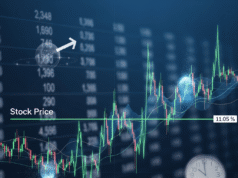The formula is: F = S × e[(R – D) × T]
Breaking Down the Variables
Here’s what each part of the formula means:
- F (Future Price): The estimated future value we’re calculating
- S (Spot Price): The current index level
- R (Risk-Free Rate): The risk-free interest rate (typically U.S. Treasury yields)
- D (Dividend Yield): The dividend yield of the index
- T (Time): The time period in years until the future date
- e (Euler’s Number): Mathematical constant approximately equal to 2.718
Practical Example
Let’s work through a real-world calculation to see how this formula operates:
Given Variables
- Current S&P 500 Level (S): $5,000
- Risk-Free Rate (R): 5% (0.05)
- Dividend Yield (D): 2% (0.02)
- Time Period (T): 6 months (0.5 years)
The Calculation
Step 1: Calculate (R – D) × T
(0.05 – 0.02) × 0.5 = 0.03 × 0.5 = 0.015
Step 2: Calculate e0.015
e0.015 ≈ 1.0151
Step 3: Multiply by current price
F = $5,000 × 1.0151 = $5,075.50
Result
The formula estimates the S&P 500 will be worth approximately $5,075 in six months, representing a gain of about $75 or 1.5%.
What This Formula Actually Tells You
This formula reveals how much the market expects the index to be worth based purely on two fundamental factors:
- Interest Rates: The cost of capital and returns on risk-free investments
- Dividends: The income distributed to shareholders by index companies
The Logic Behind It
The formula essentially answers this question: “If I could earn a risk-free return of 5% by lending money (buying Treasury bondsTreasury bonds), but stocks pay me 2% in dividends, what should the price appreciation be to make holding stocks attractive?”
The difference between the risk-free rate and dividend yield (R – D) represents the expected price appreciation needed to compensate investors for holding the equity index instead of risk-free bonds.
Important Limitations
While mathematically elegant, this formula has significant limitations traders must understand:
What It Doesn’t Include
- Market Sentiment: Investor psychology and emotional reactions
- Economic Events: Recessions, policy changes, or geopolitical shocks
- Corporate Earnings: Company profit growth or decline
- Volatility: Market uncertainty and price swings
- Supply and Demand: Actual buying and selling pressure
What It’s Actually Used For
Rather than predicting where the market will actually go, this formula is primarily used for:
- Futures Pricing: Determining fair value for index futures contracts
- Arbitrage Opportunities: Identifying when futures are mispriced relative to spot prices
- Options Strategy: Helping price derivatives based on forward expectations
- Baseline Expectations: Understanding market-implied growth before other factors
Real-World Application
Professional traders use this formula constantly, but not as a prediction tool. Instead, they compare the formula’s output to actual futures prices trading in the market.
Example Arbitrage Scenario
If the formula says six-month S&P 500 futures should be at $5,075, but the market is pricing them at $5,100, traders might:
- Sell the “overpriced” futures contract at $5,100
- Buy the underlying S&P 500 stocks at $5,000
- Wait six months and deliver the stocks against the futures contract
- Pocket the $25 difference as profit (minus transaction costs)
This arbitrage activity helps keep futures prices aligned with the formula’s “fair value.”
Key Takeaways
- Mathematical Foundation: The formula uses exponential growth based on rate differentials
- Interest Rate Sensitivity: Higher rates increase expected future values
- Dividend Impact: Higher dividend yields decrease expected price appreciation
- Time Component: Longer time periods amplify the effect of rate differences
- Limited Predictive Power: Real markets deviate significantly based on numerous other factors
Why Euler’s Number (e)?
The formula uses Euler’s number (e ≈ 2.718) because it represents continuous compounding. Interest rates and dividend yields accrue continuously over time, not in discrete chunks. Using e provides the mathematically precise answer for continuous growth rates.
For comparison, simple interest would just multiply: $5,000 × (1 + 0.015) = $5,075. The exponential version accounts for the compounding effect, though at small rates and short time periods, the difference is minimal.
The future price formula, F = S × e[(R – D) × T], isn’t a crystal ball for predicting market direction. Instead, it’s a fundamental tool for understanding the mathematical relationship between current prices, interest rates, dividend yields, and futures pricing.
For retail investors, the key insight is recognizing that markets have baseline expectations built into derivatives pricing. When you hear traders discuss “fair value” for futures contracts, they’re typically referring to calculations based on this formula.
The formula tells you what the market should price futures at based purely on the cost of carry (interest rates minus dividends). What the market actually does depends on countless other factors—corporate earnings, economic data, geopolitical events, investor sentiment, and more.
Understanding this distinction helps separate mathematical models from market reality, a crucial lesson for anyone learning about derivatives, futures, or options trading.




